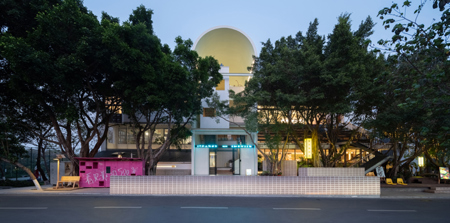

Borderless Community of FEl
FEI Architects
The building mainly used steel structure, profiled steel floor slabs and prefabricated concrete units to reflect the ecological theme of the surroundings. The project used extensively, in innovative ways, affordable recycled industrial materials. There were numerous examples like low priced PVC tubes used as walls around restrooms and staircases; FRP grilles used by garages re-employed as building’s sun shades; recycled factories skylights used as windows on the northern façade; wooden formworks used during construction of the project and old sailing boat sails recycled as interior materials, etc. To optimize use of space, the roof from 2nd to 3rd floor is designed as a stepped tree-shade theater slanting along the gradient of a living tree canopy turning part of the building envelope into public space and using people activities to compose a facade with life. Underneath the roof is a two-storey high internal street passing through the art museum, which makes arts more communal and accessible while enhancing its publicness. Interior Architecture creates space within space ,enriches its inter-reaction and provides multi-faceted publicness in it. The north-south internal street works like the “cold-lane” in traditional villages shading sunshine from west and bringing in fresh air for the art museum and design studio. The photovoltaic skylights on 2nd and 3rd floors of the small courtyard and the intelligence-controlled ventilation volume work together with the internal street to form a complete cooling and ventilation system for the building vastly reducing energy consumption.